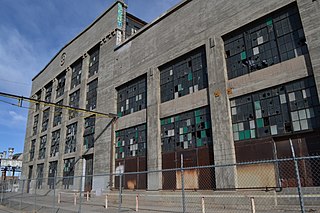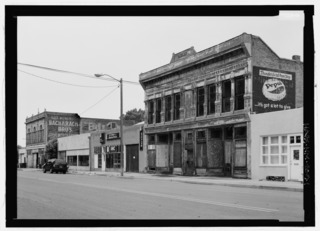
Glorieta Pass is a mountain pass in the Sangre de Cristo Mountains of northern New Mexico. The pass is at a strategic location near at the southern end of the Sangre de Cristos in east central Santa Fe County southeast of the city of Santa Fe.

Ratón Pass is a 7,834 ft (2,388 m) elevation mountain pass on the Colorado–New Mexico border in the western United States. It is located on the eastern side of the Sangre de Cristo Mountains between Trinidad, Colorado and Raton, New Mexico, approximately 180 miles (290 km) northeast of Santa Fe. Ratón is Spanish for "mouse". The pass crosses the line of volcanic mesas that extends east from the Sangre de Cristo Mountains along the state line, and furnishes the most direct land route between the valley of the Arkansas River to the north and the upper valley of the Canadian River, leading toward Santa Fe, to the south. The pass now carries Interstate 25 and railroad tracks.

The former Santa Fe Railway Shops in Albuquerque, New Mexico, consist of eighteen surviving buildings erected between 1915 and 1925. The complex is located south of downtown in the Barelas neighborhood, bounded by Second Street, Hazeldine Avenue, Commercial Street, and Pacific Avenue. The shops were one of four major maintenance facilities constructed by the Atchison, Topeka and Santa Fe Railway, the others being located in Topeka, Kansas, Cleburne, Texas, and San Bernardino, California. The railway shops were the largest employer in the city during the railroad's heyday. Currently they have been empty for years but a variety of plans have been proposed for the historic complex.

The historic U.S. Route 66 ran east–west across the central part of the state of New Mexico, along the path now taken by Interstate 40 (I-40). However, until 1937, it took a longer route via Los Lunas, Albuquerque, and Santa Fe, now roughly New Mexico State Road 6 (NM 6), I-25, and US 84. Large portions of the old road parallel to I-40 have been designated NM 117, NM 118, NM 122, NM 124, NM 333, three separate loops of I-40 Business, and state-maintained frontage roads.

Williams Depot is a privately owned train station in Williams, Arizona. It is the southern terminus of the Grand Canyon Railway line.

Las Vegas station is an Amtrak train station at Railroad Avenue and Lincoln Street in Las Vegas, New Mexico. Built in 1899, the two-story brick station building was designed in the Spanish Mission style and features a red tile roof, ornate metal brackets and a curving parapet. The station was renovated in 2000, when approximately $1.2 million was secured from federal, state and private sources. It reopened as the Las Vegas Intermodal Facility and now houses a passenger waiting room and the city's Visitor Center.

Raton is an active railroad station in the city of Raton, Colfax County, New Mexico, United States. Located at 201 South First Street, the station serves Amtrak's Southwest Chief. Connections are also available to Denver, Colorado via Amtrak Thruway Motorcoach bus service. The station is staffed during the summer season when tourism for the Philmont Scout Ranch and the National Rifle Association (NRA) Whittington Center is at its peak. During off-seasons, it is open at all train times, maintained by a caretaker. Passengers with layovers there often visit the non-profit Old Pass Gallery, located on the station grounds in the restored 1910 Railway Express Agency building. The station also includes a former freight depot.

The Barstow Harvey House, also known as Harvey House Railroad Depot and Barstow station, is a historic building in Barstow, California. Originally built in 1911 as Casa del Desierto, a Harvey House hotel and Santa Fe Railroad depot, it currently serves as an Amtrak station and government building housing city offices, the Barstow Chamber of Commerce and Visitor Center, and two museums.

Watrous, also named La Junta, is a National Historic Landmark District near Watrous, New Mexico. It encompasses the historic junction point of the two major branches of the Santa Fe Trail, a major 19th-century frontier settlement route between St. Louis, Missouri and Santa Fe, New Mexico. La Junta, marked this junction point, as well as the first major indications of civilization before westbound travelers reached Santa Fe. The district includes a large area west of the modern community of Watrous, encompassing the confluence of the Mora and Sapello Rivers. Surviving buildings include the houses of early ranchers, as well as a stagecoach mailstop and inn. The district was designated a National Historic Landmark in 1963.

The Colfax County Courthouse in Springer, New Mexico, is a building on the National Register of Historic Places that was used as a seat of county government for Colfax County, New Mexico from 1881 until 1897. The building is located at 614 Maxwell Avenue, Springer, NM 87747, and today it houses a museum devoted to the Santa Fe Trail. The building was placed on the National Register in 1987.

The Clifton House was an important overnight stage stop on the Mountain Branch of the Santa Fe Trail. It was located in Colfax County, New Mexico about six miles south of Raton, New Mexico, on the Canadian River. The site is located at mile marker 344 of U.S. Route 64, just off of exit 446 on Interstate 25.

Louis Singleton Curtiss was a Canadian-born American architect. Notable as a pioneer of the curtain wall design, he was once described as "the Frank Lloyd Wright of Kansas City". In his career, he designed more than 200 buildings, though not all were realized. There are approximately 30 examples of his work still extant in Kansas City, Missouri where Curtiss spent his career, including his best known design, the Boley Clothing Company Building. Other notable works can be found throughout the American midwest.
Atchison, Topeka and Santa Fe Railway Depot, or variations with Railroad or Station or Passenger and/or Freight may refer to any one of many stations of the Atchison, Topeka and Santa Fe Railway. These include:

The Williams Historic Business District is significant for its long time close association with the American development of tourism, which in turn became a principal local industry. The reasons for this were that the District straddled the Atchison, Topeka and Santa Fe Railway and U.S. Highway 66, two significant national transportation arteries, as well as being at the southern terminus of both rail and highway links to the Grand Canyon. The District is also historically significant because of the role it played in the cycles of opening of the frontier west, from ranching to railroading and lumbering.

The Flagstaff Railroad Addition Historic District is significant because of its association with the Atchison, Topeka and Santa Fe Railway as well as U.S. Route 66. The original boundary was roughly bounded by Santa Fe RR tracks, Agassiz and Beaver Sts., Birch and Aspen Avenues. The district was expanded twice to add nine buildings along Phoenix Avenue from Beaver Street to San Francisco Avenue, and a building at 122 East Route 66.
Edward Alfred Harrison, known as E. A. Harrison, was an American architect who worked as a staff architect for the Atchison, Topeka & Santa Fe Railway, with offices in Topeka, Kansas, and later in Chicago, Illinois.

The Atchison, Topeka and Santa Fe Railway Depot in Magdalena, New Mexico was listed on the National Register of Historic Places in 1978.

The Alvarado Hotel was a historic railroad hotel which was one of the most famous landmarks of Albuquerque, New Mexico. It was built in 1901–02 by the Atchison, Topeka and Santa Fe Railway and was operated by the Fred Harvey Company until 1970. With 120 guest rooms, it was the largest of all the Harvey hotels. Its demolition by the railroad in 1970 was described by preservationist Susan Dewitt as "the most serious loss of a landmark the city has sustained" and helped mobilize stronger support for historic preservation efforts in the city.

The Castañeda Hotel is a historic railroad hotel located in Las Vegas, New Mexico. It was built in 1898 and 1899 by the Atchison, Topeka and Santa Fe Railway, and was operated by the Fred Harvey Company until 1948. After being mostly vacant for many years, the hotel was restored and reopened in 2019. The Castañeda was listed on the New Mexico State Register of Cultural Properties in 1974 and the National Register of Historic Places in 1979 as a contributing property in the Railroad Avenue Historic District. It is located adjacent to the Las Vegas railroad station.

The Railroad Avenue Historic District is a historic district listed on the National Register of Historic Places in Las Vegas, New Mexico. It encompasses three blocks of Railroad Avenue between Jackson Street and University Avenue, as well as the first block of Lincoln Avenue. The buildings in the district were directly related to the presence of the Atchison, Topeka and Santa Fe Railway in Las Vegas and date from between 1879 and 1920.



















